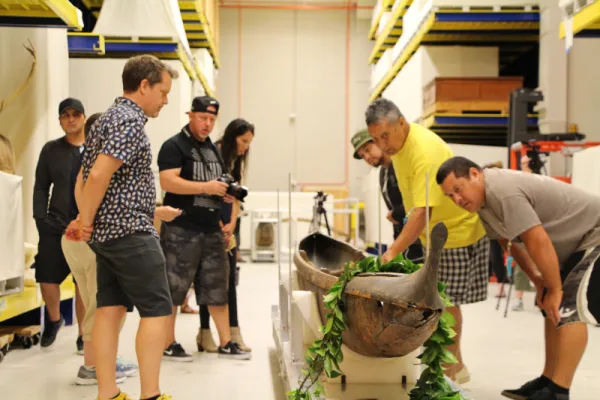
Search
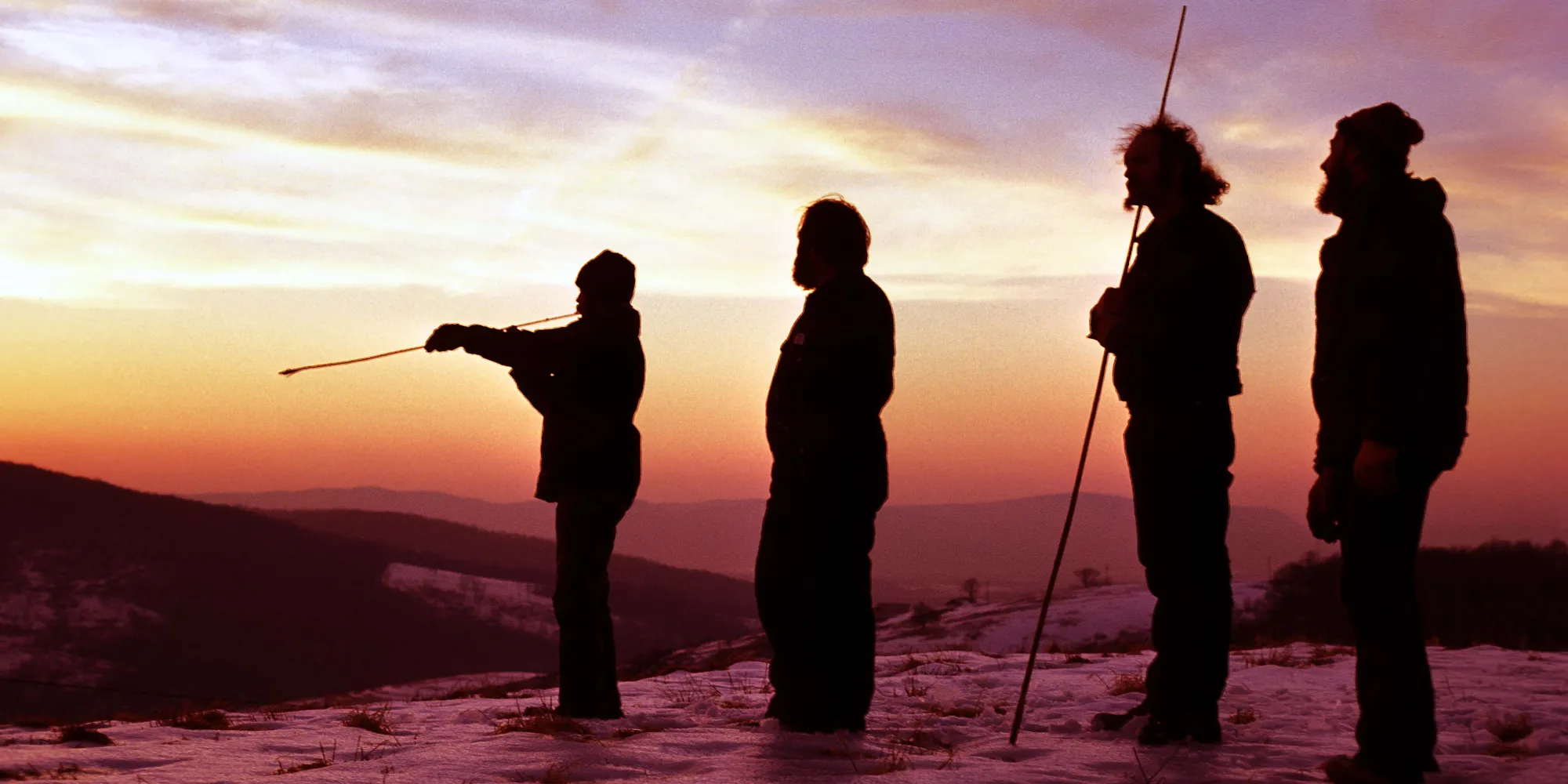
News from Recovering Voices
Navigating the Ways of the Wa’a
By: Jade Levandofsky
10/17/2018
The outrigger canoe, called “wa’a” in Hawaiian, is integral to the seafaring cultures of Oceania. Canoes are sacred and believed to hold incredible spiritual power as they have the ability to bring people together from far reaching places. When gifting someone a canoe, you are showing your connection in spite of distance, which is what Queen Kapi’olani (1834-1899) of the Kingdom of Hawai’i did in 1887 when she gifted a 100-year-old wa’a to the Smithsonian Institution.

This past June, Queen Kapi’olani’s canoe brought together Hawaiian and Māori canoe carvers to study the gifted wa’a in Washington, D.C through the Recovering Voices Community Research Program. The group consisted of father and son Hawaiian canoe carvers Ray and Alika Bumatay, master Māori carver and canoe builder and Head of School of the NZMACI Te Tapuwae o te Waka James Eruera and his students Bryce Motu and Leslie Matiu. Alexis Ching, an apprentice carver and anthropologist and Hawai’i based photographer Dino Morrow helped document the visit. The project also involved Smithsonian staff Joshua A. Bell, Curator of Globalization and Kālewa Correa, Curator of Hawai’i and the Pacific at Smithsonian Asian Pacific American Center. The visit culminated in two video calls, one with students at Te Kura Kaupapa Māori o Pukemiro, a school on the North Island of Aotearoa/New Zealand and the other with high school students in a summer program at Kamehameha Schools in Maui, Hawai’i. The Wa’a Project, as the collaboration is called, created a space for dialogue among the canoe carvers, curators and others through the visit and video calls.
The group gathered at the Smithsonian’s Museum Support Center to study the construction and repair of the 19 foot wa’a as well as its other associated parts. As part of this work the Ray and Alika used their family lashing technique to re-attach the ‘iako (booms) to both the ama (outrigger) and the wae (spreaders) of the wa’a.
Following his greeting of the canoe in Hawaiian and during the group’s initial inspection of the canoe, Ray observed that the wa’a was lonely without a paddle. He explained that wandering spirits looking for a home will see a wa’a without a paddle and can inhabit the wa’a. If this happens then rituals are required to remove an uninvited spirit. However, if a canoe paddle is present in the wa’a then the spirit knows the wa’a is already
taken and will move on. So the wa’a would no longer be lonely, Ray graciously decided to gift one of his own paddles made from koa, a Hawaiian hardwood, to the National Museum of Natural History. Once catalogued, the paddle will keep the wa’a company in collections.
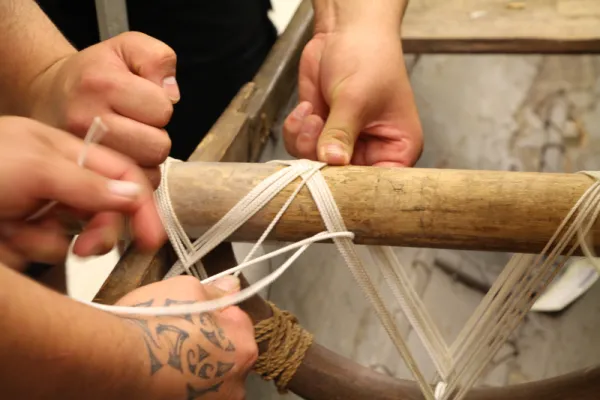
While attaching the ama (outrigger) to the hull, Ray explained the lashing style and the story of the lashing pattern. Long ago a Tahitian Princess traveled to Kauai and upon her arrival her retainers attempted to hide her identity. The people of Kauai noticed that she was being treated differently and they realized she was royalty. The King of Kauai fell in love with her and took her for his wife. The King was jealous of her beauty and ordered his head rigger to make her a chastity belt. Over time the chastity belt design was adapted as a canoe lashing pattern and is strong enough that even if part of it is cut or broken it still holds tight. It is called the Pa'u or the Dress of Princess of 'Ilukia pattern.
The video conference to students in Aotearoa/New Zealand and Hawai’i gave these groups a chance to see the wa’a and speak with the carvers and curators about their work. Students in the Kamehameha Schools Maui summer program on Hawaiian voyaging asked questions related to tools, tradition and modernity, and were interested in the mindset of the carver when building a canoe. Although the carvers admitted to using modern techniques and tools (chainsaws) to make canoes they still follow tradition. Despite the uses of new tools, the mentality and spiritual energy of the ancestors is still a part of the building process. When asked about traditional guidelines for carving a wa’a, Ray explained that every canoe is unique, like the person who builds it, and that the purpose for the wa’a should be kept in mind at all times. Surfing canoes need a wider front, while racing canoes need to be longer and more streamlined, and fishing canoes need a wider belly to carry the catch.
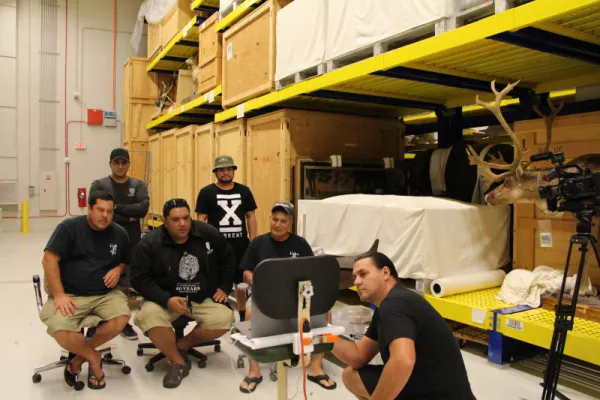
Once morning arrived in Aotearoa/New Zealand, the carvers connected with Māori students at Te Kura Kaupapa Māori o Pukemiro. This conversation focused on what the carvers learned from their time at the National Museum of Natural History and how they plan to use this new knowledge when they return home. The carvers emphasized the importance of seeing a 100+ year old canoe and being able to have full access to that knowledge. They also spoke about the importance of working with each other and sharing their different canoe building traditions. Joshua Bell described the 3D scanning of the wa’a that was completed in early June.
In addition to examining the wa’a, the group spent time studying the collection of Hawaiian and Māori adzes and other related materials in the NMNH Anthropology Collections. Prior to the modern tools used by canoe carvers, large adzes were used to carve out the canoe and smaller adzes were used for fine details. The group determined that one Hawaiian adze was constructed to allow the head to swivel, making it easier on a carver to work at an angle.
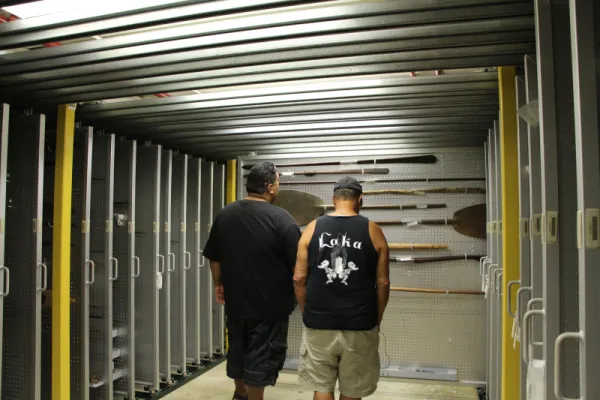
Over the eleven days of the visit to Washington, DC, the canoe carvers spent time talking story and sharing with each other and the Smithsonian their knowledge and passion for their work. As the carvers and curators planned next steps for the Wa’a Project one thing was certain, it is the wa’a that will bring the group back together again.